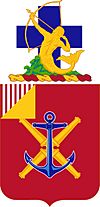10th Coast Artillery (United States) facts for kids
The 10th Coast Artillery Regiment was a special unit in the United States Army. Its main job was to protect the coast, especially the Narragansett Bay in Rhode Island. This regiment was active from 1924 to 1944. It helped guard important harbors and coastlines during its time.
Quick facts for kids 10th Coast Artillery Regiment |
|
|---|---|

Coat of arms
|
|
| Active | 1924 - 1944 |
| Country | |
| Branch | Army |
| Type | Coast artillery |
| Role | Harbor defense |
| Size | Regiment |
| Part of | Harbor Defenses of Narragansett Bay |
| Garrison/HQ | Fort Adams |
| Motto(s) | "Vaillant et Veillant" |
| Mascot(s) | Oozlefinch |
| Engagements | War of 1812 Civil War World War II |
Contents
History of the Regiment
The 10th Coast Artillery Regiment was officially formed on February 27, 1924. It started its work on July 1, 1924, at Fort Adams in Rhode Island. This happened when several existing companies of the Coast Artillery Corps were renamed to create the new regiment.
At first, only the Headquarters and Headquarters Battery (HHB) was active. This small group looked after the defenses at Narragansett Bay and New Bedford. Another unit, the 243rd Coast Artillery, was the Rhode Island National Guard's part of the Narragansett Bay defenses.
Growing the Unit
Over time, more parts of the regiment became active:
- On July 1, 1939, and September 1, 1940, Batteries A and B started their operations at Fort Wetherill.
- The HHB also managed defenses at Fort Rodman in Massachusetts until another unit took over in 1940.
- On February 10, 1941, Batteries C, D, E, and F were activated at Fort Adams. Battery C went to Fort Greene, and Batteries D, E, and F went to Fort Church.
- The 1st and 2nd Battalions, along with the HHB, became fully active on April 25, 1941.
- Battery G, a searchlight battery, started on January 6, 1941, at Fort Adams.
Later Changes
In 1943, Battery E was moved to the Portland defenses and renamed. The 10th Coast Artillery was responsible for the eastern defenses of Narragansett Bay. They also managed all the mine defenses in the bay.
On March 14, 1944, the regiment's equipment was given to the Narragansett Bay defenses. The HHB of the 10th Coast Artillery moved to Camp Forrest, Tennessee, and was officially stopped on April 10, 1944. The entire regiment was disbanded on May 31, 1944.
What Happened Next
The unit's history continued later in a different form. On June 28, 1950, the HHB was reformed as the HHB, 10th Antiaircraft Artillery Group. It was later renamed the HHB, 10th Artillery Group, on March 20, 1958.
Unit Symbols and Meanings
Military units often have special symbols and designs that tell their story. The 10th Coast Artillery Regiment had a "Distinctive Unit Insignia" and a "Coat of Arms."
Distinctive Unit Insignia
This is a small, gold-colored metal badge. It shows a triton (a mythical sea creature, half-human, half-fish) holding a bow and arrow. He is aiming over a green sea wave, in front of a blue cross.
- What it Means:
- The blue cross represents the service of Battery E, 5th Artillery, during the Civil War. This battery is now part of the 10th Coast Artillery.
- The triton with the bow and arrow symbolizes danger coming from the sea. It shows that the Coast Artillery units in their forts must protect against this danger.
- History: This badge was first approved for the 10th Coast Artillery Regiment on February 27, 1926. It was later used for the 10th Antiaircraft Artillery Automatic Weapons Battalion in 1952.
Coat of Arms
The Coat of Arms is a larger, more detailed design. It has a shield and a crest.
- The Shield:
- The shield is red, which stands for Artillery.
- It has a blue anchor, which comes from the old Coast Defenses of Narragansett Bay.
- Four cannons are arranged to form the Roman numeral "X," which is ten. This represents the 10th Regiment.
- There's also a special section called a "canton" with fifteen stripes. This part shows a connection to Battery C, 2nd Coast Artillery. That unit was at Fort McHenry when it was attacked in 1814, an event shown by the fifteen stripes.
- The Crest:
- The crest is the part above the shield. It shows the same triton with a bow and arrow over a green sea wave and a blue cross.
- Just like the insignia, the blue cross stands for the Civil War service of Battery E, 5th Artillery.
- The triton with the bow and arrow again symbolizes the danger from the sea that the Coast Artillery protects against.
- Motto: The motto of the regiment is "VAILLANT ET VEILLANT." This is French for "Valiant and Vigilant," meaning brave and watchful.
- History: The Coat of Arms was first approved for the 10th Coast Artillery on February 27, 1926. It was later used for the 10th Antiaircraft Artillery Automatic Weapons Battalion in 1952.
Awards and Honors
The 10th Coast Artillery Regiment did not receive any special campaign streamers or decorations.
Images for kids


